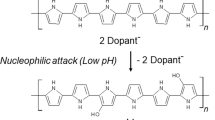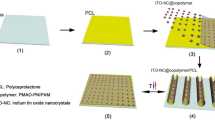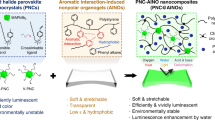Abstract
Polypyrrole, poly(N-methyl pyrrole) and poly(N-ethyl pyrrole) grains were synthesized by aqueous chemical oxidative polymerization in the presence of sodium dodecyl sulfate as both a dopant and a hydrophobizing agent. The resulting grain products were characterized in terms of their size, morphology, surface and bulk chemical compositions, hydrophilic–hydrophobic balance, (photo)thermal property, and conductivity. Scanning electron microscopy studies indicated that the grains were aggregates of atypical particles with submicrometer size. Elemental microanalysis and thermogravimetric analysis confirmed the production of dodecyl sulfate-doped polypyrrole, poly(N-methyl pyrrole) and poly(N-ethyl pyrrole) materials, and they showed near-infrared light-to-heat photothermal properties, which was confirmed by thermography. The data obtained through X-ray photoelectron spectroscopy indicated the presence of dodecyl sulfate dopants on the surface of the grains. The dried polypyrrole and poly(N-ethyl pyrrole) grains showed hydrophobic character, and therefore, they can adsorb to the air–water interface and act as a light-responsive liquid marble stabilizer. Locomotion of the liquid marble can be driven by near-infrared laser irradiation-induced Marangoni flow on a planar air–water surface. The release of internal liquid can be achieved by controlled disruption of liquid marbles via external stimulus application.
This is a preview of subscription content, access via your institution
Access options
Subscribe to this journal
Receive 12 print issues and online access
$259.00 per year
only $21.58 per issue
Buy this article
- Purchase on Springer Link
- Instant access to full article PDF
Prices may be subject to local taxes which are calculated during checkout








Similar content being viewed by others
References
Aussillous P, Quéré D. Properties of liquid marbles. Proc R Soc A. 2006;462:973–99. https://doi.org/10.1098/rspa.2005.1581
Bormashenko E. Liquid marbles, elastic nonstick droplets: From minireactors to self-propulsion. Langmuir. 2017;33:663–9. https://doi.org/10.1021/acs.langmuir.6b03231
McHale G, Newton MI. Liquid marbles: Topical context within soft matter and recent progress. Soft Matter. 2015;11:2530–46. https://doi.org/10.1039/C5SM00084J
Fujii S, Yusa S, Nakamura Y. Stimuli-responsive liquid marbles: controlling structure, shape, stability, and motion. Adv Funct Mater. 2016;26:7206–23. https://doi.org/10.1002/adfm.201603223
Oliveira NM, Reis RL, Mano JF. The potential of liquid marbles for biomedical applications: a critical review. Adv Heal Mater. 2017;6:1700192. https://doi.org/10.1002/adhm.201700192
Fujii S. Stimulus-responsive soft dispersed systems developed based on functional polymer particles: bubbles and liquid marbles. Polym J. 2019;51:1081–101. https://doi.org/10.1038/s41428-019-0233-0
Xue Y, Wang H, Zhao Y, Dai L, Feng L, Wang X, et al. Magnetic liquid marbles: a “precise” miniature reactor. Adv Mater. 2010;22:4814–8. https://doi.org/10.1002/adma.201001898
Gao W, Lee HK, Hobley J, Liu T, Phang IY, Ling XY. Graphene liquid marbles as photothermal miniature reactors for reaction kinetics modulation. Angew Chem Int Ed. 2015;54:3993–6. https://doi.org/10.1002/anie.201412103
Sheng Y, Sun G, Wu J, Ma G, Ngai T. Silica-based liquid marbles as microreactors for the silver mirror reaction. Angew Chem Int Ed. 2015;54:7012–7. https://doi.org/10.1002/anie.201500010
Zang D, Li J, Chen Z, Zhai Z, Geng X, Binks BP. Switchable opening and closing of a liquid marble via ultrasonic levitation. Langmuir. 2015;31:11502–7. https://doi.org/10.1021/acs.langmuir.5b02917
Sato E, Yuri M, Fujii S, Nishiyama T, Nakamura Y, Horibe H. Liquid marbles as a micro-reactor for efficient radical alternating copolymerization of diene monomer and oxygen. Chem Commun. 2015;51:17241–4. https://doi.org/10.1039/C5CC07421E
Dupin D, Armes SP, Fujii S. Stimulus-responsive liquid marbles. J Am Chem Soc. 2009;131:5386–7. https://doi.org/10.1021/ja901641v
Yusa S, Morihara M, Nakai K, Fujii S, Nakamura Y, Maruyama A, et al. Thermo-responsive liquid marbles. Polym J. 2014;46:145–8. https://doi.org/10.1038/pj.2013.84
Bormashenko E, Musin A. Revealing of water surface pollution with liquid marbles. Appl Surf Sci. 2009;255:6429–31. https://doi.org/10.1016/j.apsusc.2009.02.027
Geyer F, Asaumi Y, Vollmer D, Butt HJ, Nakamura Y, Fujii S. Polyhedral liquid marbles. Adv Funct Mater. 2019;29:1808826. https://doi.org/10.1002/adfm.201808826
Bormashenko E, Pogreb R, Bormashenko Y, Musin A, Stein T. New investigations on ferrofluidics: Ferrofluidic marbles and magnetic-field-driven drops on superhydrophobic surfaces. Langmuir. 2008;24:12119–22. https://doi.org/10.1021/la802355y
Dampeirou C. Hydrophobic silica-based powder containing xylitol or trehalose and water for base of cosmetics. 2005;WO2005034917A2.
Fujii S, Sawada S, Nakayama S, Kappl M, Ueno K, Shitajima K, et al. Pressure-sensitive adhesive powder. Mater Horiz. 2016;3:47–52. https://doi.org/10.1039/C5MH00203F
Paven M, Mayama H, Sekido T, Butt HJ, Nakamura Y, Fujii S. Light-driven delivery and release of materials using liquid marbles. Adv Funct Mater. 2016;26:3199–206. https://doi.org/10.1002/adfm.201600034
Kawashima H, Paven M, Mayama H, Butt HJ, Nakamura Y, Fujii S. Transfer of materials from water to solid surfaces using liquid marbles. ACS Appl Mater Interfaces. 2017;9:33351–9. https://doi.org/10.1021/acsami.7b11375
Kawashima H, Mayama H, Nakamura Y, Fujii S. Hydrophobic polypyrroles synthesized by aqueous chemical oxidative polymerization and their use as light-responsive liquid marble stabilizers. Polym Chem. 2017;8:2609–18. https://doi.org/10.1039/C7PY00158D
Kawashima H, Okatani R, Mayama H, Nakamura Y, Fujii S. Synthesis of hydrophobic polyanilines as a light-responsive liquid marble stabilizer. Polymer. 2018;148:217–27. https://doi.org/10.1016/j.polymer.2018.06.039
Shimogama N, Uda M, Oyama K, Hanochi H, Hirai T, Nakamura Y, et al. Hydrophobic poly(3,4-ethylenedioxythiophene) particles synthesized by aqueous oxidative coupling polymerization and their use as near-infrared-responsive liquid marble stabilizer. Polym J. 2019;51:761–70. https://doi.org/10.1038/s41428-019-0189-0
Inoue H, Hirai T, Hanochi H, Oyama K, Mayama H, Nakamura Y, et al. Poly(3-hexylthiophene) grains synthesized by solvent-free oxidative coupling polymerization and their use as light-responsive liquid marble stabilizer. Macromolecules. 2019;52:708–17. https://doi.org/10.1021/acs.macromol.8b02426
Kavokine N, Anyfantakis M, Morel M, Rudiuk S, Bickel T, Baigl D. Light-driven transport of a liquid marble with and against surface flows. Angew Chem Int. Ed. 2016;55:11183–7. https://doi.org/10.1002/anie.201603639
Skotheim TA, Reynolds J. Handbook of conducting polymers. 3rd ed. Florida: CRC Press; 2007.
Otero TF. Conducting polymers: Bioinspired intelligent materials and devices. London: RSC; 2016.
Attar HAA, Kabbi ASA, Faris FA. Polypyrrole conductive polymer characteristics as an optical display device. Polym Eng Sci. 1999;39:2482–6. https://doi.org/10.1002/pen.11635
Yuan X, Ding XL, Wang CY, Ma ZF. Use of polypyrrole in catalysts for low temperature fuel cells. Energy Environ Sci. 2013;6:1105–24. https://doi.org/10.1039/C3EE23520C
Deshpande PP, Sazou D. Corrosion protection of metals by intrinsically conducting polymers. New York, USA: CRC Press; 2015.
Mecerreyes D, Alvaro V, Cantero I, Bengoetxea M, Calvo PA, Grande H, et al. Low surface energy conducting polypyrrole doped with a fluorinated counterion. Adv Mater. 2002;14:749–52. https://doi.org/10.1002/1521-4095(20020517)14
Hara S, Zama T, Takashima W, Kaneto K. Artificial muscles based on polypyrrole actuators with large strain and stress induced electrically. Polym J. 2004;36:151–61. https://doi.org/10.1295/polymj.36.151
Guimard NK, Gomez N, Schmidt CE. Conducting polymers in biomedical engineering. Prog Polym Sci. 2007;32:876–921. https://doi.org/10.1016/j.progpolymsci.2007.05.012
Balint R, Cassidy NJ, S. Cartmell SH. Conductive polymers: towards a smart biomaterial for tissue engineering. Acta Biomater. 2014;10:2341–53. https://doi.org/10.1016/j.actbio.2014.02.015
Eftekhari A, Kazemzad M, Rad MK. Significant effect of dopant size on nanoscale fractal structure of polypyrrole film. Polym J. 2006;38:781–5. https://doi.org/10.1295/polymj.PJ2005173
Olsen GW, Butenhoff JL, Zobel LR. Perfluoroalkyl chemicals and human fetal development: An epidemiologic review with clinical and toxicological perspectives. Reprod Toxicol. 2009;27:212–30. https://doi.org/10.1016/j.reprotox.2009.02.001
Sonkar R, Kay MK, Choudhury M. PFOS modulates interactive epigenetic regulation in first-trimester human trophoblast cell line HTR-8/SVneo. Chem Res Toxicol. 2019;32:2016–27. https://doi.org/10.1021/acs.chemrestox.9b00198
Singer MM, Tjeerdema RS. Fate and effects of the surfactant sodium dodecyl sulfate. In: Ware GW, editors. Reviews of environmental contamination and toxicology. Reviews of environmental contamination and toxicology, vol. 133. New York, NY: Springer; 1993.
Bondi CAM, Marks JL, Wroblewski LB, Raatikainen HS, Lenox SR, Gebhardt KE. Human and environmental toxicity of sodium lauryl sulfate (SLS): evidence for safe use in household cleaning products. Environ Health Insights. 2015;9:27–32. https://doi.org/10.4137/EHI.S31765
Liu Y, Chu Y, Yang L. Adjusting the inner-structure of polypyrrole nanoparticles through microemulsion polymerization. Mater Chem Phys. 2006;98:304–8. https://doi.org/10.1016/j.matchemphys.2005.09.025
Ovando-Medina VM, Peralta RD, Mendizábal E, Martínez-Gutiérrez H, Lara-Ceniceros TE, Ledezma-Rodríguez R. Synthesis of polypyrrole nanoparticles by oil-in-water microemulsion polymerization with narrow size distribution. Colloid Polym Sci. 2011;289:759–65. https://doi.org/10.1007/s00396-011-2394-z
Beadle PM, Armes SP, Greaves SJ, Watts JF. X-ray photoelectron spectroscopy studies on sterically-stabilized polypyrrole particles. Langmuir. 1996;12:1784–8. https://doi.org/10.1021/la950746o
Takeoka H, Fukui N, Sakurai S, Nakamura Y, Fujii S. Nanomorphology characterization of sterically stabilized polypyrrole-palladium nanocomposite particles. Polym J. 2014;46:704–9. https://doi.org/10.1038/pj.2014.44
Fujii S, Hamasaki H, Abe H, Yamanaka S, Ohtaka A, Nakamura E, et al. One-step synthesis of magnetic iron-conducting polymer-palladium ternary nanocomposite microspheres with applications as recyclable catalyst. J Mater Chem A. 2013;1:4427–30. https://doi.org/10.1039/c3ta10389g
Martínez JML, Denis MFL, Denaday LR, Orto VCD. Development and characterization of a new polyampholyte-surfactant complex applied to the solid phase extraction of bisphenol-A. Talanta. 2009;80:789–96. https://doi.org/10.1016/j.talanta.2009.07.065
Ćirić-Marjanović G, Mentus S, Pašti I, Gavrilov N, Krstić J, Travas-Sejdic J, et al. Synthesis, characterization, and electrochemistry of nanotubular polypyrrole and polypyrrole-derived carbon nanotubes. J Phys Chem C. 2014;118:14770–84. https://doi.org/10.1021/jp502862d
Omastová M, Trchová M, Kovářová J, Stejskal J. Synthesis and structural study of polypyrroles prepared in the presence of surfactants. Synth Met. 2003;138:447–55. https://doi.org/10.1016/S0379-6779(02)00498-8
Ishii K, Sato K, Oaki Y, Imai H. Highly porous polymer dendrites of pyrrole derivatives synthesized through rapid oxidative polymerization. Polym J. 2019;51:11–8. https://doi.org/10.1038/s41428-018-0115-x
Kostić R, Raković D, Stepanyan SA, Davidova IE, Gribov LA. Vibrational spectroscopy of polypyrrole, theoretical study. J Chem Phys. 1995;102:3104–9. https://doi.org/10.1063/1.468620
Lu Y, Shi G, Li C, Liang Y. Thin polypyrrole films prepared by chemical oxidative polymerization. J Appl Polym Sci. 1998;70:2169–72. https://doi.org/10.1002/(sici)1097-4628(19981212)70
Su W, Iroh JO. IR and XPS studies on the interphase and poly(N-methylpyrrole) coatings electrodeposited on steel substrates. Electrochim Acta. 1999;44:3321–32. https://doi.org/10.1016/S0013-4686(99)00055-9
Arjomandi J, Safdar S, Malmir M. In situ UV-visible spectroelectrochemistry and cyclic voltammetry of conducting N-methylpyrrole: indole copolymers on gold electrode. J Electrochem Soc. 2012;159:E73–81. https://doi.org/10.1149/2.023204jes
Ge H, Qi G, Kang ET, Neoh KG. Study of overoxidized polypyrrole using X-ray photoelectron spectroscopy. Polymer. 1994;35:504–8. https://doi.org/10.1016/0032-3861(94)90503-7
Rodríguez I, Scharifker BR, Mostany J. In situ FTIR study of redox and overoxidation processes in polypyrrole films. J Electroanal Chem. 2000;491:117–25. https://doi.org/10.1016/S0022-0728(00)00194-7
Armes SP, Gottesfeld S, Beery JG, Garzon F, Agnew SF. Conducting polymer-colloidal silica composites. Polymer. 1991;32:2325–30. https://doi.org/10.1016/0032-3861(91)90068-T
Tsai EW, Basak S, Ruiz JP, Reynolds JR, Rajeshwar K. Electrochemistry of some β-substituted polythiophenes anodic oxidation, electrochromism, and electrochemical deactivation. J Electrochem Soc. 1989;136:3683–9. https://doi.org/10.1149/1.2096530
Fujii S, Armes SP, Jeans R, Devonshire R, Warren S, McArthur SL, et al. Synthesis and characterization of polypyrrole-coated sulfur-rich latex particles: New synthetic mimics for sulfur-based micrometeorites. Chem Mater. 2006;18:2758–65. https://doi.org/10.1021/cm0601741
Bhattacharya A, De A, Das S. Electrochemical preparation and study of transport properties of polypyrrole doped with unsaturated organic sulfonates. Polymer. 1996;37:4375–82. https://doi.org/10.1016/0032-3861(96)00183-8
Perruchot C, Chehimi MM, Delamar M, Lascelles SF, Armes SP. Surface characterization of polypyrrole-coated polystyrene latex by X-ray photoelectron spectroscopy. Langmuir. 1996;12:3245–51. https://doi.org/10.1021/la960057s
Mravćáková M, Omastová M, Olejníková K, Pukánszky B, Chehimi MM. The preparation and properties of sodium and organomodified-montmorillonite/polypyrrole composites: a comparative study. Synth Met. 2007;157:347–57. https://doi.org/10.1016/j.synthmet.2007.04.005
Liu MJ, Tzou K, Gregory RV. Influence of the doping conditions on the surface energies of conducting polymer. Synth Met. 1994;63:67–71. https://doi.org/10.1016/0379-6779(94)90251-8
Gelmi A, Ljunggren MK, Rafat M, Jager EWH. Influence of conductive polymer doping on the viability of cardiac progenitor cells. J Mater Chem B. 2014;2:3860–7. https://doi.org/10.1039/C4TB00142G
Li F, Winnik MA, Matvienko A, Mandelis A. Polypyrrole nanoparticles as a thermal transducer of NIR radiation in hot-melt adhesives. J Mater Chem. 2007;17:4309–15. https://doi.org/10.1039/B708707A
Au KM, Chen M, Armes SP, Zheng N. Near-infrared light-triggered irreversible aggregation of poly(oligo(ethylene glycol) methacrylate)-stabilized polypyrrole nanoparticles under biologically relevant conditions. Chem Commun. 2013;49:10525–7. https://doi.org/10.1039/C3CC46385K
Grzeszczuka M, Kepas A, Kvarnstrom C, Ivaska A. Effects of small octahedral mono, di, and trivalent hexafluoroanions on electronic and molecular structures of polypyrrole monitored by in situ UV–vis–NIR and resonance Raman spectroelectrochemical measurements. Synth Met. 2010;160:636–42. https://doi.org/10.1016/j.synthmet.2009.12.024
Bredas JL, Scott JC, Yakuschi K, Street GB. Polarons and bipolarons in polypyrrole: Evolution of the band structure and optical spectrum upon doing. Phys Rev B. 1984;30:1023–5. https://doi.org/10.1103/PhysRevB.30.1023
Jarosz T, Krukiewicz K, Lapkowski M, Domagala W. Spectroelectrochemical techniques as modern tools for investigating charge transfer processes in conjugated polymers. Chemik. 2015;69:485–90.
Han CC, Lee JT, Yang RW, Chang H, Han CH. A new and easy method for making micrometer-sized carbon tubes. Chem Commun. 1998;118:2087–8. https://doi.org/10.1039/A805057K
Rozlívková Z, Trchová M, Exnerová M, Stejskal J. The carbonization of granular polyaniline to produce nitrogen-containing carbon. Synth Met. 2011;161:1122–9. https://doi.org/10.1016/j.synthmet.2011.03.034
Yamamoto D, Shioi A. Self-propelled nano/micromotors with a chemical reaction: underlying physics and strategies of motion control KONA Powder and Particle. Powder Part J. 2015;32:2–22. https://doi.org/10.14356/kona.2015005
Wang H, Pumera M. Fabrication of micro/nanoscale motors. Chem Rev. 2015;115:8704–35. https://doi.org/10.1021/acs.chemrev.5b00047
Sánchez S, Soler L, Katuri J. Chemically powered micro- and nanomotors. Angew Chem Int Ed. 2015;54:1414–44. https://doi.org/10.1002/anie.201406096
Xu L, Mou F, Gong H, Luo M, Guan J. Light-driven micro/nanomotors: From fundamentals to applications. Chem Soc Rev. 2017;46:6905–26. https://doi.org/10.1039/C7CS00516D
Fujii S, Suzaki M, Armes SP, Dupin D, Hamasaki S, Aono K, et al. Liquid marbles prepared from pH-responsive sterically-stabilized latex particles. Langmuir. 2011;27:8067–74. https://doi.org/10.1021/la201317b
Fujii S, Aono K, Suzaki M, Hamasaki S, Yusa S, Nakamura Y. pH-Responsive hairy particles synthesized by dispersion polymerization with a macroinitiator as an inistab and their use as a gas-sensitive liquid marble stabilizer. Macromolecules. 2012;45:2863–73. https://doi.org/10.1021/ma300048m
Vargaftik NB, Volkov BN, Voljak LD. International tables of the surface tension of water. J Phys Chem Ref Data. 1983;12:817. https://doi.org/10.1063/1.555688
Ramkumar DHS, Kudchadker AP. Mixture properties of the water +.gamma.-butyrolactone + tetrahydrofuran system. Part 2. Viscosities and surface tensions of.gamma.-butyrolactone + water at 303.15-343.15 K and.gamma.-butyrolactone + tetrahydrofuran at 278.15-298.15 K. J Chem Eng Data. 1989;34:463–5. https://doi.org/10.1021/je00058a027
Acknowledgements
This work was supported by a Grant-in-Aid for Scientific Research (B) (JSPS KAKENHI Grant Number JP16H04207) and the International Association for the Exchange of Students for Technical Experience (IAESTE). San-Ei Gen F.F.I., Inc. is thanked for a kind donation of Sunred YM dye.
Author information
Authors and Affiliations
Corresponding author
Ethics declarations
Conflict of interest
The authors declare that they have no conflict of interest.
Additional information
Publisher’s note Springer Nature remains neutral with regard to jurisdictional claims in published maps and institutional affiliations.
Rights and permissions
About this article
Cite this article
Šišáková, M., Asaumi, Y., Uda, M. et al. Dodecyl sulfate-doped polypyrrole derivative grains as a light-responsive liquid marble stabilizer. Polym J 52, 589–599 (2020). https://doi.org/10.1038/s41428-020-0307-z
Received:
Revised:
Accepted:
Published:
Issue Date:
DOI: https://doi.org/10.1038/s41428-020-0307-z
This article is cited by
-
Morphological and chemical stabilities of polypyrrole in aqueous media for 1 year
Polymer Journal (2022)
-
Polypyrrole-coated Pickering-type droplet as light-responsive carrier of oily material
Colloid and Polymer Science (2022)



